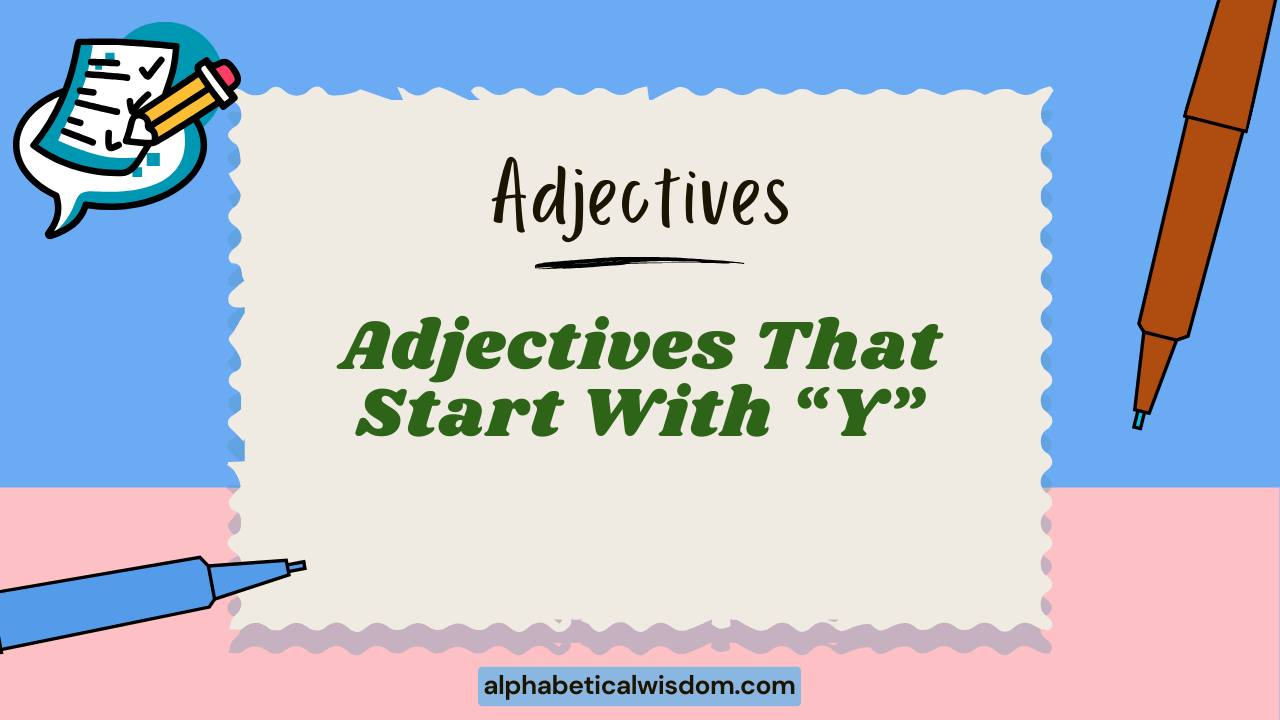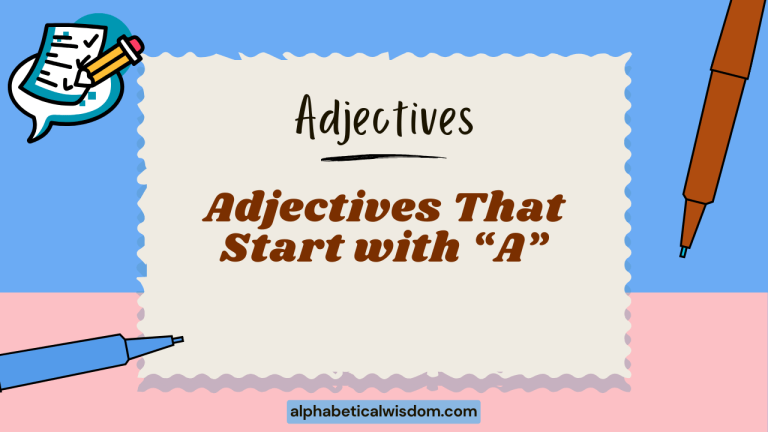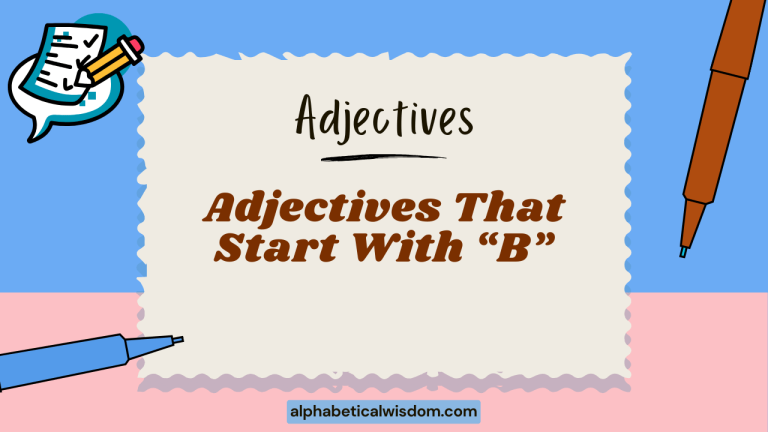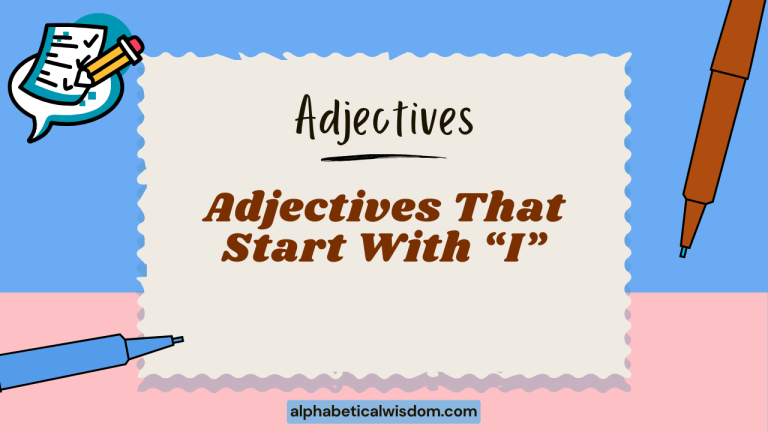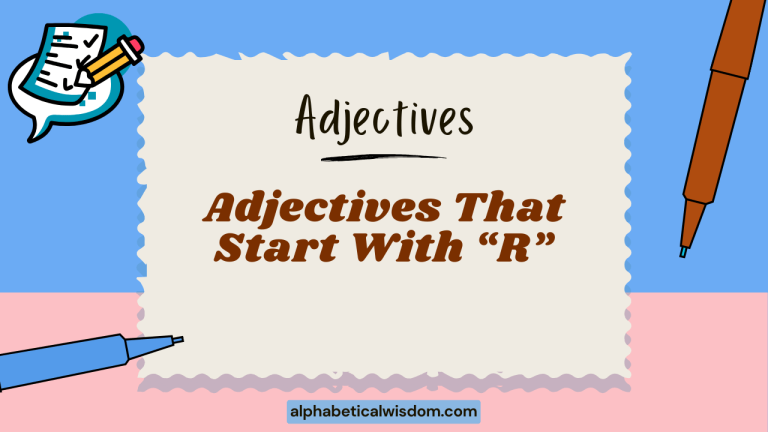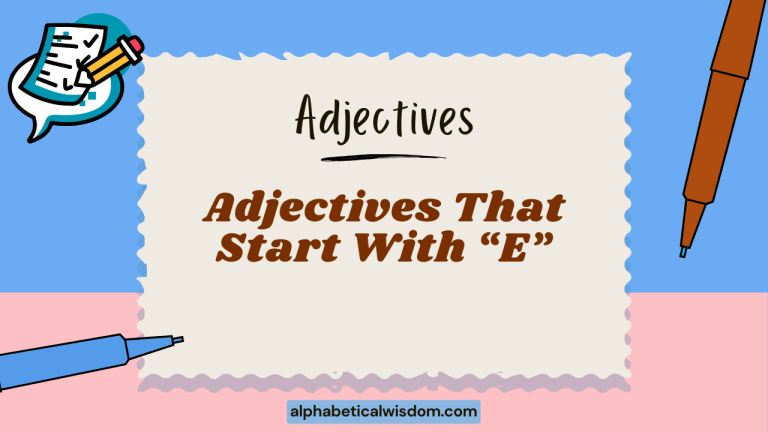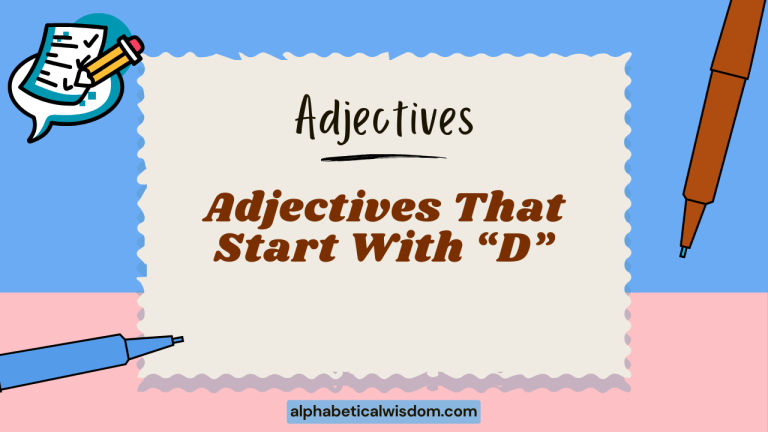Adjectives That Start With Y: Your Comprehensive Guide
Adjectives are the colorful words that paint a vivid picture of nouns, adding depth and detail to our language. While some letters boast a vast collection of adjectives, others, like ‘Y,’ offer a more curated selection.
Mastering adjectives that begin with ‘Y’ can enhance your vocabulary, making your writing and speech more precise and engaging. This comprehensive guide is designed for English language learners of all levels, from beginners seeking to expand their basic vocabulary to advanced speakers aiming to refine their expressive abilities.
Whether you’re a student, writer, or simply a language enthusiast, this article will equip you with the knowledge and practice to confidently use ‘Y’ adjectives in any context.
This article provides a detailed exploration of adjectives starting with ‘Y,’ covering their definitions, structural characteristics, usage rules, and common mistakes. You will find numerous examples, practice exercises, and frequently asked questions to solidify your understanding.
By the end of this guide, you’ll not only know a variety of ‘Y’ adjectives but also understand how to use them effectively to enrich your communication.
Table of Contents
- Definition of Adjectives
- Structural Breakdown of Adjectives
- Types and Categories of ‘Y’ Adjectives
- Examples of ‘Y’ Adjectives
- Usage Rules for ‘Y’ Adjectives
- Common Mistakes with ‘Y’ Adjectives
- Practice Exercises
- Advanced Topics
- Frequently Asked Questions
- Conclusion
Definition of Adjectives
An adjective is a word that modifies a noun or pronoun. Its primary function is to describe, identify, or quantify the noun or pronoun, providing additional information about it. Adjectives answer questions like “What kind?”, “Which one?”, “How many?”, or “How much?” They add detail and specificity, making language more descriptive and engaging. Without adjectives, our descriptions would be bland and lack nuance.
Adjectives play a crucial role in sentence structure and meaning. They can appear before the noun they modify (attributive position) or after a linking verb (predicative position).
Understanding the function and placement of adjectives is essential for constructing grammatically correct and expressive sentences.
Structural Breakdown of Adjectives
Adjectives, while often simple in form, can be structurally complex. They can be single words, compound words, or even phrases.
The structure of an adjective often influences its meaning and usage. Simple adjectives consist of a single word, such as “yellow” or “young.” Compound adjectives are formed by combining two or more words, often hyphenated, such as “year-round” or “yellow-green”.
Adjectival phrases consist of a group of words that function as an adjective, such as “young at heart.”
Adjectives can also be modified by adverbs to further refine their meaning. For example, in the phrase “very young,” the adverb “very” intensifies the adjective “young.” Understanding these structural elements allows for a more precise and nuanced use of adjectives in writing and speech.
Types and Categories of ‘Y’ Adjectives
Adjectives, including those starting with ‘Y,’ can be categorized based on their function and the type of information they convey. The most common categories include descriptive adjectives and quantitative adjectives.
Descriptive Adjectives
Descriptive adjectives describe the qualities or characteristics of a noun. They provide information about color, size, shape, texture, or other attributes.
Examples of descriptive ‘Y’ adjectives include “yellow,” “youthful,” and “yummy.” These adjectives add sensory detail and help create a more vivid picture in the reader’s mind.
Quantitative Adjectives
Quantitative adjectives indicate the quantity or amount of a noun. While less common with the letter ‘Y,’ adjectives that imply a quantity or degree can fall into this category.
For example, “yearly” implies a quantity related to time.
Examples of ‘Y’ Adjectives
To illustrate the usage of adjectives starting with ‘Y,’ here are several examples categorized by their commonality and complexity. These examples demonstrate how ‘Y’ adjectives can be used in various contexts to add detail and specificity to sentences.
Common ‘Y’ Adjectives
These are frequently used ‘Y’ adjectives that are essential for everyday communication. Understanding their meaning and usage is crucial for basic English proficiency.
The table below provides examples of these adjectives in sentences.
Here’s a table showcasing common adjectives that start with ‘Y’ and their usage in sentences:
| Adjective | Example Sentence |
|---|---|
| Yellow | The sun cast a yellow glow over the fields. |
| Young | She is a young and promising artist. |
| Yummy | This cake is absolutely yummy! |
| Yearly | We have a yearly family reunion. |
| Youthful | Her youthful energy is contagious. |
| Yielding | The soil was yielding to the gardener’s touch. |
| Your | Is this your book? |
| Yesterday’s | Yesterday’s news is old news. |
| Yonder | The farm is on the yonder hill. |
| You | (Implied) You are responsible. |
| Year-long | They embarked on a year-long journey around the world. |
| Yard-sale | We found a treasure at the yard-sale. |
| Yeast | The bread has a yeast flavor. |
| Yelping | The yelping dog ran across the park. |
| Yes | It was a yes vote. |
| Yoga | She likes yoga pants. |
| Yodeling | The yodeling singer was talented. |
| Yttric | The rock contained yttric elements. |
| Yugoslavian | The restaurant served Yugoslavian cuisine. |
| Yukon | The Yukon trail was challenging. |
| Yuppie | The yuppie lifestyle was expensive. |
| Yearned-for | The vacation was a yearned-for escape. |
| Yarrow | The garden was filled with yarrow plants. |
| Youth-oriented | The brand was youth-oriented. |
| Y-shaped | The road was Y-shaped. |
| Yesterday | Yesterday afternoon was productive. |
| Youngish | He was a youngish man. |
| Yourself | (Implied) Be yourself. |
| Year-end | The year-end sale was popular. |
This table provides a variety of common adjectives starting with ‘Y,’ illustrating their diverse usage in different contexts. By studying these examples, learners can gain a better understanding of how to incorporate these adjectives into their vocabulary and writing.
Advanced ‘Y’ Adjectives
These are less frequently used adjectives that can add sophistication and precision to your language. While not essential for basic communication, mastering these adjectives can significantly enhance your vocabulary and expressive abilities.
The table below provides examples of these adjectives in sentences.
Here is a table with more advanced ‘Y’ adjectives and their use in sentences:
| Adjective | Example Sentence |
|---|---|
| Yearling | The yearling colt showed great promise. |
| Yclept | The knight, yclept Sir Reginald, was brave and true. |
| Yellowish | The old paper had a yellowish tint. |
| Yemeni | The restaurant served authentic Yemeni dishes. |
| Yesterday | Yesterday’s events are still fresh in my mind. |
| Yo-yo | The company’s profits had a yo-yo effect. |
| Young-looking | She was a young-looking woman for her age. |
| Youth-related | The conference addressed youth-related issues. |
| Yttiferous | The mineral sample was found to be yttiferous. |
| Yugoslav | The museum displayed Yugoslav artifacts. |
| Yummy-looking | The yummy-looking dessert was tempting. |
| Year-round | The resort offers year-round activities. |
| Yelpingly | (Adverbial but derived from adjective) The dog ran yelpingly away. |
| Yieldingly | (Adverbial but derived from adjective) The branch bent yieldingly in the wind. |
| Youthfully | (Adverbial but derived from adjective) She danced youthfully across the stage. |
| Yearly | (Can function as adverb) The report is presented yearly. |
| Yare | The sailor was yare and ready for the voyage. |
| Yellow-bellied | He was a yellow-bellied coward. |
| Young-at-heart | My grandmother is young-at-heart. |
| Yesterday-like | The event felt yesterday-like. |
| Yourself-reliant | She is a yourself-reliant woman. |
| Yeast-based | The recipe called for a yeast-based starter. |
| Yodeling-style | He sang in a yodeling-style manner. |
| Yttric-oxide | The experiment involved yttric-oxide compounds. |
| Yugoslavian-born | The artist was Yugoslavian-born. |
| Yukon-bound | The travelers were Yukon-bound. |
| Yuppie-influenced | The architecture was yuppie-influenced. |
| Yearned-for-freedom | They sought a yearned-for-freedom. |
| Yarrow-infused | The tea was yarrow-infused. |
This table expands on the previous one by introducing more complex and less common ‘Y’ adjectives. These examples are useful for learners who wish to refine their language skills and add a layer of sophistication to their vocabulary.
To further illustrate the usage, consider the following examples:
- The yearling horse was full of energy.
- The old map had a yellowish hue.
- The Yemeni coffee was strong and aromatic.
Usage Rules for ‘Y’ Adjectives
Adjectives, including those starting with ‘Y,’ follow specific rules regarding their placement and form. Understanding these rules is essential for constructing grammatically correct and clear sentences.
Attributive Position
In the attributive position, the adjective appears before the noun it modifies. This is the most common placement for adjectives.
For example:
- The yellow flower bloomed in the spring.
- The young boy played in the park.
Predicative Position
In the predicative position, the adjective appears after a linking verb (such as “is,” “are,” “was,” “were,” “seems,” or “becomes”) and describes the subject of the sentence. For example:
- The flower is yellow.
- The boy seems young.
Comparative and Superlative Forms
Many adjectives, including some that start with ‘Y,’ can form comparative and superlative degrees to indicate different levels of intensity. For most one-syllable adjectives, the comparative is formed by adding “-er” and the superlative by adding “-est.” For longer adjectives, “more” and “most” are used.
For example:
- Young: younger, youngest
- Yummy: more yummy, most yummy (though less common)
Here is a table illustrating the comparative and superlative forms of some common ‘Y’ adjectives:
| Adjective | Comparative Form | Superlative Form |
|---|---|---|
| Young | Younger | Youngest |
| Youthful | More Youthful | Most Youthful |
| Yummy | More Yummy | Most Yummy |
Note that some adjectives, particularly those that are less commonly used or are already strong in meaning, may not typically form comparative and superlative degrees.
Common Mistakes with ‘Y’ Adjectives
Even experienced English speakers can make mistakes when using adjectives. Here are some common errors to watch out for when using ‘Y’ adjectives:
- Incorrect use of comparative/superlative forms: Saying “younget” instead of “youngest.”
- Misplacing adjectives in a sentence: For example, “Flower yellow the” instead of “The yellow flower.”
- Using adjectives as adverbs: Using “yellow” to describe how something is done instead of an adverb like “yellowishly.”
Here’s a table illustrating some of these common mistakes and their corrections:
| Incorrect | Correct | Explanation |
|---|---|---|
| She is the younget girl. | She is the youngest girl. | Correct superlative form. |
| Flower yellow the is. | The flower is yellow. | Correct word order. |
| The sun shone yellow. | The sun shone yellowishly. | Use of adverbial form. (Or, “The sun had a yellow glow.”) |
By being aware of these common mistakes, learners can avoid errors and improve the accuracy of their English usage.
Practice Exercises
To solidify your understanding of ‘Y’ adjectives, complete the following exercises. These exercises are designed to test your knowledge of adjective identification, usage, and comparative/superlative forms.
Exercise 1: Identifying Adjectives
Identify the adjective in each of the following sentences. If there is no adjective, write “None.”
- The yellow car sped down the street.
- She is a young and talented musician.
- The cake tasted yummy.
- They have a yearly subscription.
- The sky is blue.
- He is very tall.
- The old house stood on the hill.
- She wore a beautiful dress.
- The book is interesting.
- I like coffee.
Answer Key:
- Yellow
- Young, talented
- Yummy
- Yearly
- Blue
- Tall
- Old
- Beautiful
- Interesting
- None
Exercise 2: Using Adjectives in Sentences
Complete the following sentences by filling in the blank with an appropriate adjective starting with ‘Y.’
- The _______ sun warmed our faces.
- She has a _______ spirit.
- The food was so _______ that we ate it all.
- We attend the conference on a _______ basis.
- He maintains a _______ appearance through exercise.
- The _______ dog barked loudly.
- Is that _______ cat?
- _______ news report.
- The house on the _______ hill.
- _______ are responsible for your actions.
Answer Key: (Possible answers)
- Yellow
- Youthful
- Yummy
- Yearly
- Youthful
- Yelping
- Your
- Yesterday’s
- Yonder
- You
Exercise 3: Comparative and Superlative Forms
Provide the comparative and superlative forms of the following adjectives.
- Young
- Youthful
- Yummy
- Yare
Answer Key:
- Young: Younger, Youngest
- Youthful: More Youthful, Most Youthful
- Yummy: More Yummy, Most Yummy
- Yare: More Yare, Most Yare
These exercises provide a comprehensive review of ‘Y’ adjectives, covering identification, usage, and comparative/superlative forms. By completing these exercises, learners can reinforce their understanding and improve their fluency.
Here’s a table summarizing the key points from the practice exercises:
| Exercise | Focus | Key Takeaway |
|---|---|---|
| Exercise 1 | Identifying Adjectives | Ability to recognize adjectives in sentences. |
| Exercise 2 | Using Adjectives | Skill in incorporating ‘Y’ adjectives into sentences. |
| Exercise 3 | Comparative/Superlative Forms | Understanding how to form comparative and superlative degrees. |
Advanced Topics
For advanced learners, there are more complex aspects of adjective usage to explore. These include hyphenated adjectives and adjectival phrases.
Hyphenated ‘Y’ Adjectives
Hyphenated adjectives are formed by combining two or more words, often to create a more specific or nuanced meaning. Examples include “year-round” and “yellow-green.” These adjectives function as a single unit and modify the noun that follows them.
It’s important to use hyphens correctly to avoid ambiguity.
Examples:
- The year-round resort offered activities in every season.
- The painting featured a yellow-green hue.
Adjectival Phrases with ‘Y’
Adjectival phrases are groups of words that function as an adjective. These phrases can add detail and complexity to a sentence.
For example, “young at heart” is an adjectival phrase that describes someone’s spirit or attitude.
Examples:
- Despite her age, she was young at heart.
- The event was designed for those young in spirit.
Understanding these advanced topics allows learners to use adjectives with greater precision and creativity, enhancing their overall language proficiency.
Frequently Asked Questions
Here are some frequently asked questions about adjectives, particularly those starting with ‘Y’:
- What is the difference between an adjective and an adverb?
An adjective modifies a noun or pronoun, while an adverb modifies a verb, adjective, or another adverb. Adjectives describe things, while adverbs describe actions or qualities.
- Can an adjective start with any letter of the alphabet?
Yes, adjectives can start with any letter, although some letters have more adjectives than others.
- How do I know where to place an adjective in a sentence?
Adjectives usually come before the noun they modify (attributive position) or after a linking verb (predicative position).
- What are comparative and superlative adjectives?
Comparative adjectives compare two things (e.g., “younger”), while superlative adjectives compare three or more things (e.g., “youngest”).
- Are there any exceptions to the rules of adjective usage?
Yes, there are exceptions. For example, some adjectives do not form comparative and superlative degrees, and some adjectives have irregular forms.
- Can I use multiple adjectives to describe a noun?
Yes, you can use multiple adjectives, but it’s important to consider the order in which they are placed. Generally, adjectives of opinion come before adjectives of fact.
- What is a compound adjective?
A compound adjective is formed when two or more words are joined together to modify a noun. These are often hyphenated, such as “year-round”.
- How can I improve my understanding of adjectives?
Read widely, pay attention to how adjectives are used in context, and practice using them in your own writing and speech. Use a dictionary and grammar resources to clarify any doubts.
- Can a noun act as an adjective?
Yes, a noun can sometimes function as an adjective. This is called a noun adjunct or attributive noun. For example, in “yoga pants,” the noun “yoga” modifies the noun “pants.”
- Is it always necessary to use adjectives in my writing?
No, it’s not always necessary. However, adjectives can add detail, clarity, and interest to your writing. Use them judiciously to enhance your descriptions and make your writing more engaging.
Conclusion
Mastering adjectives, including those that start with the letter ‘Y,’ is crucial for effective communication in English. Adjectives add detail, specificity, and color to your language, making your writing and speech more engaging and precise.
By understanding the different types of adjectives, their usage rules, and common mistakes, you can significantly improve your fluency and confidence.
This guide has provided a comprehensive overview of ‘Y’ adjectives, including definitions, examples, practice exercises, and frequently asked questions. Remember to continue practicing and expanding your vocabulary to further enhance your language skills.
With dedication and effort, you can confidently use ‘Y’ adjectives and other descriptive words to express yourself effectively in any context.
